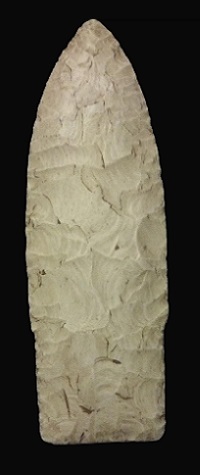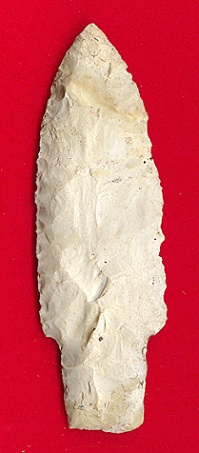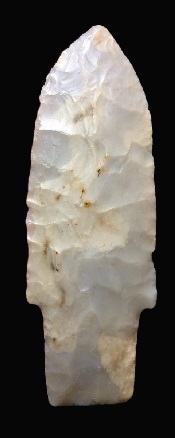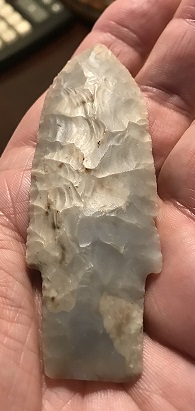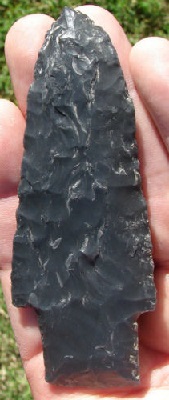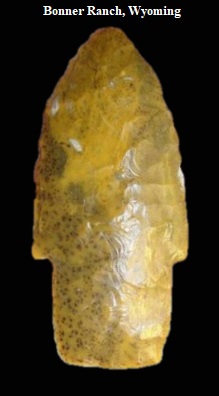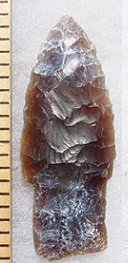Outline is Representative of Size and Shape:
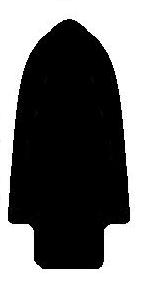
Name Details:
Identified By: H. Maria Wormington
Named For: Alberta, Canada
Date Identified: 1957
Type Site:
Identified By: H. Maria Wormington
Named For: Alberta, Canada
Date Identified: 1957
Type Site:
Point Validity:
Valid type
Wormington was a renowned anthropologist and was known as the foremost expert on Paleo Archeology. This point was published in a professional publication and is considered a valid type.
Wormington was a renowned anthropologist and was known as the foremost expert on Paleo Archeology. This point was published in a professional publication and is considered a valid type.
Alberta Stemmed
Cluster: Plano Stemmed Cluster Description of Physical Characteristics and Flaking Pattern:
This is
a small (1.25 to 1.75 inch) triangular stemmed to expanding stem point with a flattened cross section. The blade is primarily straight with a sharp tip. The stem is long and
slightly expanding. The base may range from straight to slightly
convex. This point has a random flaking pattern. This is a medium to large lanceolate shaped stemmed point with an elliptical cross section that is even, but thick. The blade is primarily excurvate with a blunted tip. The shoulders are primarily horizontal and commonly weak. The stem broad, elongated and straight being longer than they are wide. Rarely the stem may slightly expand or slightly contract. The base may vary from straight to slightly convex. Heavy basal and lateral edge hafting region grinding is commonly seen on this point. This point is manufactured using even percussion flaking and finished with fine long even pressure flaking forming a parallel flaking pattern
Size Measurements:
Total Length - 50 to 150 mm, Stem Length - 13 to 25 mm (1/3 to 1/10 the total length), Width - 25 to 45 mm, Stem Width - 20 to 30 mm (Suhm and Krieger, 1954).
Total Length - 50 to 150 mm, Stem Length - 13 to 25 mm (1/3 to 1/10 the total length), Width - 25 to 45 mm, Stem Width - 20 to 30 mm (Suhm and Krieger, 1954).
Commonly Utilized Material:
Available material often high quality or exotic materials. Heat treatment is not used on this point.
Available material often high quality or exotic materials. Heat treatment is not used on this point.
Additional Comments:
These points are similar to the Scottsbluff points except these points tend to be large with a longer and broader stem and a blunted tip (Drager and Ireland, 1986). The stem is longer than it is wide. This is a key characteristic in distinguishing this type from the similar Scottsbluff point. In addition, the Alberta point tends to be thicker than Scottsbluff points and have less refined pressure flaking (Morrow, 2016). He also notes that Alberta points exhibit a design that is intermediate between Hell Gap and Scottsbluff points.
These points are similar to the Scottsbluff points except these points tend to be large with a longer and broader stem and a blunted tip (Drager and Ireland, 1986). The stem is longer than it is wide. This is a key characteristic in distinguishing this type from the similar Scottsbluff point. In addition, the Alberta point tends to be thicker than Scottsbluff points and have less refined pressure flaking (Morrow, 2016). He also notes that Alberta points exhibit a design that is intermediate between Hell Gap and Scottsbluff points.
Distribution: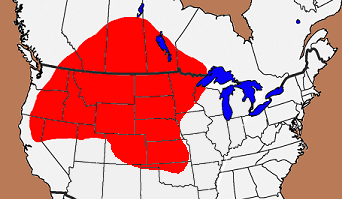

Distribution Comments:
This point is commonly found in the prairies of Alberta and Saskatchewan and into the northern plain states of the U.S. Found into the west to the eastern edge of the Rocky Mountains and into the panhandle of Oklahoma and up into Minnesota.
This point is commonly found in the prairies of Alberta and Saskatchewan and into the northern plain states of the U.S. Found into the west to the eastern edge of the Rocky Mountains and into the panhandle of Oklahoma and up into Minnesota.
Age / Periods:
Date: 9,250 - 8,850 B.P.
Cultural Period: Transitional Paleo to
Early Archaic
Glacial Period: Early Holocene
Culture: Cody Complex
Date: 9,250 - 8,850 B.P.
Cultural Period: Transitional Paleo to
Early Archaic
Glacial Period: Early Holocene
Culture: Cody Complex
Age Details:

